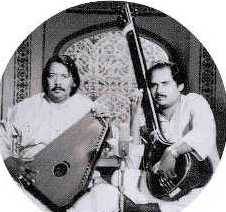|
|
|









Music in Pakistan - The Story of Five Decades
by
 Khalid Manzoor Basra
Khalid Manzoor Basra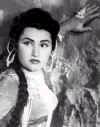
About the Author: Late Dr.
Khalid Basra wrote this article a little over three years ago - perhaps his last
piece of writing. He wrote it for a publication that I was editing at the time.
Dr. Basra was a senior civil servant in Pakistan - and a lot more. An aesthete,
a scholar (he earned his PhD in Music from School of Oriental & African
Studies, London), a keen sitar player, an able administrator - he was a free and
a humane spirit. He passed away from this world three years ago at the age of
39. – Editor
The city of Lahore was arguably the most important cultural centre in the entire North India on the eve of independence. It retains that position in contemporary Pakistan but has not been able to recover from the loss it suffered due to the Partition. Lahore produced some of the pioneering names in modern classical, popular and film music of the region and had a wide collection of individuals, venues and institutions supporting musical activity.
Lahore’s most interesting feature was the organisation of musical activity around takiyahs and baithaks where some of the leading musicians of the times could be interacted with socially and musically. Takiyah, was the name given ti inns. In 19th century several such establishments existed around Lahore to house travellers when the city gates were locked at sunset. Most of these takiyahs were just outside the walled city and by their nature provided avenues for congregation and social activity frequently featuring musical performances. At least one, Takiyah Mirasian still retains its entity. it is just outside Mochi Darwaza in Lahore and has been the site of some historic musical performances.
Baithak (a place to sit) was a subsequent institution performing roughly similar functions as a takiyah. before the partition, almost every prominent musician had his baithak where he also taught pupils. Baithaks of Ustad Barkat Ali Khan, Ustad Sardar Khan and many others were very vibrant institutions.
These institutions of gharana (Gharana is Urdu for family; lineage. In the context of music, it has evolved as a term for a school of music) and ustad-shagird (an academic/devoted relationship between teacher and pupli) created a musical idiom and were supported by the patronage of affluent Hindus and Sikhs, who left at the time of Partition.
Lahore
Radio
Music was one of the major cultural traditions affected most profoundly by the division of the sub-continent. Pakistan inherited a large number of front ranking artists but the large network of patronage rooted in the wealthy Hindu and Sikh middle class was lost. Departure of pupils and connoisseurs from these communities left musicians (who were largely Muslims) to the vagaries of chance careers.
Radio was the only established institution at the time to which musicians could turn to. In 1947 Pakistan inherited two stations, one at Lahore and the other at Peshawar. The next to go on air was in the capital Karachi on 14th August 1948. Today there are 22, covering 75 percent of the area and 95 percent of the population.
For music, radio was the most important state institution that emerged in the British era and continued to retain this unique and influential position well after Independence. It substituted the princely states’ patronage towards musicians of note. Well known musicians had a princely lifestyle and only States could afford them. Radio made such musicians more accessible to the masses.
The Lahore Radio had on its regular staff well known instrumentalists, composers and vocalists. At the time of Independence the list for Lahore Radio Station included names of the legendary tabla player Mian Qadir Bakhsh (the teacher of two of the greatest tabla players of our times, Zakir Hussain’s father Ustad Allah Rakha and the late Ustad Shaukat Hussain), Bhai Lal of the rababi family and Ustad Niaz Hussain Shami of Sham Chaurasi (who worked here as a composer), Shamshad Begum and Surinder Kaur.
Lahore Radio is also credited with the launching of the careers of two of the most popular film singers of the sub-continent, Noor Jehan and Mohammad Rafi. Lahore boasted of the richest collection of musicians at the time in entire North India. A decade before the partition when Lahore station came into existence, its first day’s artists included the legendary Inayat Bai Dheroo Vali and Ustad Barkat Ali Khan. Roshan Ara Begum sang on the second day travelling specially from Bombay for the programme.
However, after the 1947 division, most patrons of music crossed over to India, and the musicians who stayed behind sought the patronage of radio station and its directors.The instrumentalists had the opportunity to work at the radio as staff artists and thus get a regular salary. The leading vocalists could perform only as casual artists. Radio’s first chief in Pakistan, Z.A. Bokhari had a serious interest in classical music. He wrote a treatise on music ‘Raag Dariya’ (Raga of Rivers) and developed a strong tradition of marsiya (religious music) and singing of Iqbal’s poetry on the radio. Bokhari’s keen musical interest ensured that music had a handsome contribution in all these activities and radio was thus able to provide jobs to a number of musicians as members of orchestra and composers. Some highly talented instrumentalists like the sarod player Nazar Hussain left their original instruments and became very successful composers.
Increased criticism from orthodox quarters influenced the official policy which proceeded to discourage thumris and dadras as these echoed ‘predominantly sensuous and amorous themes’. (Dadra - a musical genre, sung in a tal cycle of six beats stresses the words more than the musical intricacies in its rendition as opposed to the thumri, a genre of singing, light and amorous in character, which employs intricate melismatic patterns and stresses musical lines more than the words).
While instrumentalists moved to orchestras, the vocalists did not have that option. Practitioners of genres like dhrupad (a musical genre, a composition, regarded as the oldest extant musical genre in North India), thumri and dadra were the hardest hit - these were dubbed as Hindu in ethos. A number of fine vocalists and instrumentalists were forced to look for other careers. Some emerged as composers and some had to take up new instruments as the orchestras of radio, recording companies and film did not have the taste or the need for their specialisation. Though thumris and dadras were rejected, the khayal and the ghazal were retained. (Khayal, a musical genre which succedded dhrupad, has greater pliability of structure. Its origins are linked to Amir Khusrau).
Similarly, important instruments such as, veena, pakhavaj, sarod and sarangi disappeared from the scene and many other instruments and vocal genres are now without major practitioners.
The craft of traditional musical instrument manufacturing has also suffered due to the lack of demand. At the time of Partition Lahore was a major centre for traditional instrument manufacturing and also had a number of shops dealing in western instruments. While the latter have disappeared altogether, the former retain a reduced activity. Lahore is the main centre of the trade and caters to other parts of the country as well. The main family running the business is the family of Ustad Ramzan Khan (born 1930) whose father Ustad Sher Muhammad died early 1997 at the age of about 90. The late Ustad was awarded the Presidential Medal for Pride of Performance for his unique expertise in manufacturing a large range of instruments. His son Ustad Ramzan is regarded as the one of the leading sitar makers of contemporary times by leading professionals with whom he has worked and is also the repository of a large range of special techniques in instrument manufacture and repair.
One of the most prominent sitar makers of India, Rikhi Ram who is now survived by his son and grandsons running the business in Delhi trained with Ustad Ramzan’s family to learn the art of sitar making. He had a shop in Anarkali bazaar.
Lahore also has a large number of shops dealing in harmonium and tabla manufacture, which are the two largest selling instruments - as these are used by nearly everyone involved with music.
At present institution engaged in some meaningful archival activity is the Classical Music Research Cell which is now housed in the basement of the Lahore radio station. The Cell was conceived in 1972 and after government’s approval started functioning under the supervision of the famous poet, the late Faiz Ahmad Faiz in 1976. The Cell faced several problems in the intervening years, and today it is the zeal of two individuals - Mr. M. A. Sheikh and Mr. Saeed Qureshi - which is responsible for the survival of the Cell. Through personal efforts and interest, they have collected a large amount of recordings, rare books and material and information about the music and musicians of Pakistan. The Cell also has a large collection of photographs of musicians and has also published a few original and translated works of music.
Pathaney Khan
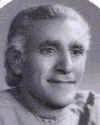 Pathaney
Khan
Pathaney
Khan
Amongst the pioneers in the
field of folk music’s presentation were Alam Lohar, Sain Akhtar, Sain Marna,
Khameesoo Khan, Misri Khan and to some extent Zahida Parveen as a large portion
of her repertoire could be categorised as Sufi as well as folk. These artists
frequently toured abroad and also published LPs. The genre had a sympathetic
treatment from the official media also and a number of official bodies also
supported its conservation and publication but the real boost came with the
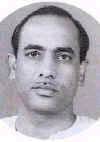
advent of cassette when Ataullah Esakhelvi and Abida Parveen became mega hits. The present day scene is dominated by Alam’s son Arif, Ataullah, Abida Parveen, Sohrab Fakir and Allan. A number of traditional drummers and instrumentalists like Pappu Sain from Lahore are also coming to prominence. Another prominent names of recent past include Pathaney Khan and Tufail Niazi. The genre has also attracted considerable international attention and a number of these groups have performed and recorded abroad.
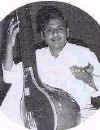
The
recent trends in pop music have created certain unique blends of indigenous folk
music themes with the western pop themes. Some of these like Abrar-ul- Haq’s
‘Billo’ have become mega hits and have also been sold to Bombay Films. A
number
USTAD GHULAM ALI
of other musicians are also active in evolving styles closely modelled on similar patterns.
Mehdi Hasan
Ghulam Ali
This is essentially a poetic genre which has a strong tradition of singing attached to it. At the time of partition the great exponent of ghazal singing Ustad Barkat Ali Khan was active in Lahore. As the genre received avowed official patronage, a large number of musicians tried their hands at it. Those exclusively known for ghazal singing are Ijaz Hussain Hazravi, Fareeda Khanum, Iqbal Bano and the two great contemporary stylists; Ghulam Ali and Mehdi Hassan. Also known (partly) for ghazal singing are Ustad Amanat Ali Khan, Hamid Ali Khan, Nusrat Fateh Ali Khan, Shahida Parveen and Abida Parveen. The genre received a great boost in Pakistan due to the fact that some of the best poets, in the last fifty years, lived in Pakistan.
Pakistani Film Music
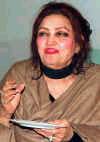 The power of film, and film
music in South Asian society can hardly be overstated. Highlighting
the point, Pradip Krishen observes, "Urban environments are cluttered with
its signs, filled with its sounds. Its tastes and values spill out to define the
very texture of contemporary mass and middle-class culture". This mass
culture affects a wide range of activities, but perhaps its most important
effect is on music. Film music is the most widely listened to music in South
Asia , and since 1931 (the year of the first Indian talkie and the first film
song) it has become the dominant force in the construction
The power of film, and film
music in South Asian society can hardly be overstated. Highlighting
the point, Pradip Krishen observes, "Urban environments are cluttered with
its signs, filled with its sounds. Its tastes and values spill out to define the
very texture of contemporary mass and middle-class culture". This mass
culture affects a wide range of activities, but perhaps its most important
effect is on music. Film music is the most widely listened to music in South
Asia , and since 1931 (the year of the first Indian talkie and the first film
song) it has become the dominant force in the construction
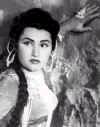
of
musical taste.
The Legend Noorjehan - as a film star; in her later years
Film music in Pakistan has largely been dominated by one female voice, that of Noorjehan. She was already in the prime of her career when Lata Mangeshkar made her debut as a play-back singer in Bombay before Partition. Before the era of play-back singing, Noorjehan was an actress-singer. After Partition, she migrated to Lahore with her husband, Shaukat Hussain Rizvi, the famous producer/ director and film-editor who started Shah Noor Studios in Lahore, one of the centres of Pakistani film activity for the last fifty years. The legendary male film singer Muhammad Rafi made his own debut singing a duet with her. Noorjehan may well have recorded more songs than all the other vocalists in Pakistan films put together. Noorjehan has a full throated voice capable of handling lower registers with remarkable command, a quality that makes her equally at ease with Punjabi and Urdu songs. Her versatility has rendered a large number of her songs part of the region’s collective musical memory.
The Punjab and especially Lahore have made a significant contribution to the film music of India. One pioneering film music director, Ustad Jhande Khan, was a native of Gujranwala, a town 40 miles north-west of Lahore, and the man who introduced Lata to films, Master Ghulam Haidar, was from a rababi family of Lahore. In the late 1940s many of the leading film personalities, music directors and musicians in Bombay were from Lahore or the surrounding areas.
Until the 1960’s Pakistani film music enjoyed a robust period of creative activity with a great number of songs acquiring popularity across the sub-continent. The major music directors of this period (with the noted exception of Khawaja Khurshid Anwar) were mostly rababis. Some of the great names were, Master Inayat Hussain, G.A. Chishti, Rashid Attre, Master Tasadduq, Master Abdullah, Firoze Nizami, Tufail Farooqi and Ustad Nazar. During the early 1960s Urdu film and music quality declined as the result of various factors. The dominance of trend-setting music directors who had experience of Bombay declined and they were replaced by a new and younger generation who tapped the Punjabi film market.
Despite the upheaval of Partition and the later ban on Indian films, Bombay film music continued to have a strong impact on the musical tastes of the middle classes in Pakistan through the medium of radio. Farmaishi programmes on All India Radio featured a large number of letters from Pakistan. Radio Ceylon was a trend-setting station that featured commercial advertisements and broadcast long hours of film music, which could be heard all over the sub-continent. Located in Bombay, it pioneered commercial ‘top of the charts’ type programmes (known as ‘Binaca Geet Mala’, sponsored by Binaca tooth paste) and enjoyed huge audience participation. Since it was not subject to the policy restrictions in force on the Indian or Pakistani state radios, which had to broadcast a range of programmes from educational to agricultural, it broadcast Indian film music almost exclusively through the day.
Although some Pakistani radio farmaishi programmes using local film music also had a regular audience, the influence enjoyed by Indian film songs was paramount.
Music in Pakistan - The
Story of Five Decades
(cntd)
by
Khalid Manzoor Basra
Classical
Music
Pakistan had a rich representation of all the musical gharanas at the time of partition and the radio had no dearth of talent in this regard. In years to come it arguably developed a musical culture blending elements from all these schools of musical practice.
|
In 1947 the front ranking vocalists in Pakistan were: the
great dhrupad singer
Mohar-e-Mauseeqi Malikzada Mian Mehar Ali Khan (the father of Malikzada
Muhammad Afzal Khan, Malikzada Muhammad Roshan
Ara Begum, Ustad
Tawakkal Hussain Khan Ustad
Bhai Lal Muhammad and his son Ghulam Hussain Shaggan (Gawalior and
Kapurthala gharanas), Niaz
Hussain Shami, |
The instrumentalists in 1947 included Ustad Mian Qadir Bakhsh Pakhavaji Ustad Sharif Khan
Poonchwalay Ustad Fateh Ali Khan Ustad Habib Ali Khan Ustad Bundu Khan and his son
Umrao Bundu Khan, Ustad Allah Ditta, Ustad Nazar Hussain |
A large number of major practitioners of various genres and instruments unfortunately died prior to the media boost and could not be properly recorded, preserved and appreciated. Amongst the instrument traditions of accompaniment, tabla and sarangi both have suffered very badly. Only one major sarangi player, Ustad Nazim Ali Khan is alive. In the period 1993- 96 the three major tabla players of the modern times, Ustad Shaukat Hussain Khan, Ustad Talib Hussain Khan and Ustad Baba Tufail died. None of their calibre remains. Altaf Hussain Tafo could be termed their contemporary but he does not have a record of accompaniment and is mainly known for solo playing in his highly individual style and composing film music. Among the contemporary tabla-players the prominent are Bashir Ahmad, Abdus Sattar Tari, Khalifa Akhtar Jan-ul-Hassan Khan and Ghulam Abbas. Tari and Ghulam Abbas live in the U.S.A., visiting Pakistan occasionally.
The two great sitar players Ustad Sharif Khan and Ustad Fateh Ali Khan are survived by their sons and a few pupils. A number of non-family musicians of amateur background are also prominent in the field. Another major sitar player is Ustad Rais Khan who migrated from India to settle here after getting married to the film singer Bilquis Khanum. His active career, however, is in singing ghazals in which he is not very prominent but which is a more lucrative pursuit in financial terms.
The major classical singers include Roshan Ara Begum,Ustad Salamat Ali Khan, Ustad Fateh Ali Khan, Ustad Ghulam Hussain Shaggan, Hamid Ali Fateh Ali and Imtiaz Ali Riaz Ali.
The tenacity and strength of the classical music tradition of the country, the belief system of the practitioners and some of its genres are perhaps best embodied in the example of the Talwandi Gharana of dhrupad singers, the only known practitioners of the genre in Pakistan. A brief survey of their history would also show various important forces at work in the period under review.
The Talwandi gharana of dhrupad singers
At the time of Partition the family was headed by the great dhrupad singer Mohar-e-Mauseeqi Malikzada Mian Mehar Ali Khan. He was born in 1913 trained by his uncle and father in law, Mian Maula Bakhsh and migrated with him to the rich town of Lyallpur in his youth on the invitation of a wealthy Sikh patron. This was a smooth transition after the loss of princely patronage. Till the time of Partition the family performed in traditional settings before highly select audiences cultivating interest in the rich genres of alap and dhrupad.
Departure at the time of Partition to India of Sardar Harcharan Singh left the family of these great dhrupad singers to the vagaries of chance, and after the exhaustion of funds and savings had to turn to the official media with whom they had some success in early fifties due to the personal interest of the Director General Z.A.Bukhari. After Bukhari, the family was left without any support from the media and was mainly supported by the younger son's (Malikzada Muhammad Hafeez Khan) employment with government and private sector in non-musical capacities. The family however continued its daily practice of music and also taught pupils and performed whenever possible.
This resulted in the brothers Malikzada Muhammad Afzal Khan and Malikzada Muhammad Hafeez Khan springing into prominence. Their resurgence also coincides with the resurgence of interest in dhurpad the oldest extant genre of music in our tradition in the Indo-Pak sub continent. The duo has travelled and performed abroad, has evoked considerable research interest and despite all possible opposition from the official media and its attempts at artificial reinterpretation of cultural heritage to suit vested interest continues to flourish and transmit its rich knowledge of music to pupils in the family and outside the family. It also has attracted foreigners who are in training in Lahore where the family’s main proponent Malikzada Muhammad Hafeez Khan resides. The example adequately indicates that such strong forces cannot be diverted and manipulated easily. It also indicates that despite all the criticism levelled against the modern media (even by the orthodox musicians) it is a liberating force which has provided some support to even very esoteric art forms by the general liberation that it has injected in the patronage and propagation structures.
